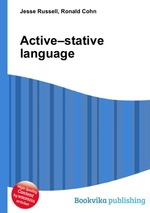Active–stative language
Jesse Russell Ronald Cohn
бумажная книга
High Quality Content by WIKIPEDIA articles! An active–stative language (active language for short), also commonly called a split intransitive language, is a language in which the sole argument ("subject") of an intransitive clause (often symbolized as S) is sometimes marked in the same way as an agent of a transitive verb (that is, like a subject such as "I" or "she" in English), and sometimes in the same way as a direct object (such as "me" or "her" in English). The case or agreement of this intransitive argument (S) depends on semantic or lexical criteria particular to each language. These criteria tend to be based on the degree of volition or control over the verbal action exercised by the participant. For example, if one tripped and fell, an active–stative language might require them to say the equivalent of "fell me"; saying "I fell" would mean that they had done it on purpose, such as taking a fall in boxing. Another possibility is empathy; for example, if someone`s dog was run over by a car, they might say the equivalent of "died her"; to say "she died" would imply that they were not affected emotionally.


